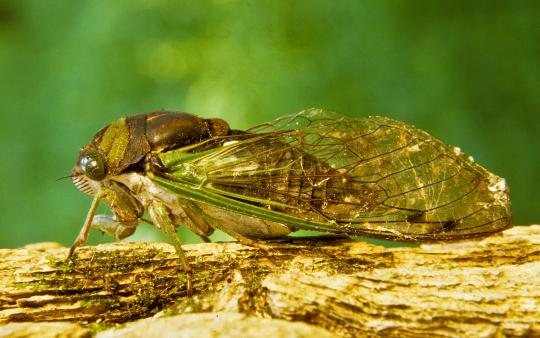No fall evening feels the same without the steady, rhythmic chorus of cricket song. The sound conjures up starlit nights, the spicy smell of fallen leaves, and the warmth of a crackling fire.
Cricket song and sounds
Crickets sing for the same reason frogs and birds do: to attract a mate. A male cricket rubs its wings together in an act called stridulation. The bottom of one wing has a hardened edge, or “scraper,” while the bottom of the other has a toothed ridge, or “file.” Each time the scraper hits a tooth, a click is produced. This causes the wings themselves to vibrate, creating the familiar cricket sound we all know so well! Because the rubbing is so fast, these individual clicks blend together into more musical chirrups or trills.

What do different crickets sound like?
Different species of insects produce distinctive song patterns! Sometimes it’s hard to tell the difference between a cricket’s song and those of other insects. Here are some of the more common sounds they make. How many do you recognize?
| Insect species | Season | AM | PM | Call description | |
|---|---|---|---|---|---|
| Four-spotted tree cricket | Mid-August to early-October | X | X | High, non-stop mechanical trill | |
| Snowy tree cricket | Late July to October | X | Soft, rich, evenly spaced chirps: “Treet….treet….treet…” | ||
| Field cricket | Early May to October | X | X | Clear, loud chirps made at one per second | |
| Allard's ground cricket | July to November | X | X | Continuous, soft, even trill; pleasant to the ear | |
| Marsh Meadow grasshopper | July to October | X |
|
||
| Carolina locust | Mid-July to October | X |
|
||
| Dog-day cicada | July to mid-September | X | X |
High-pitched, sustained buzz that starts out softly and increases in volume |

Females crickets don’t produce sound but they do listen by using their front legs, which is where their eardrum, or tympanum, is located. You can tell the difference between a male and female cricket quite easily: female crickets have three “tails” (the middle is her oviposter used to inject eggs into the soil) while males only have two!
A game of crickets!
"Find a mate"
(6 to 20 players)
- Select a “female” cricket (the gender of the player doesn’t matter!). The rest are “males.”
- Blindfold the female (remember she lives in the long grass and can’t see the males).
- Using the chart below, whisper one of the cricket patterns in the female cricket’s ear—this is the sound she’ll be seeking out using only her hearing as a guide!
- Now whisper a different cricket chirrup to each male cricket—these are the sounds they’ll be singing to the female.
- With the male crickets standing in a large circle around the female, have the males sing their chirrups. Just like a meadow on a warm summer’s evening, there will be a cacophony of cricket songs!
Can the female cricket find the male of her species? Let her carefully move about the circle listening carefully for the right pattern of chirrups.
| 5 long chirrups | 2 long chirrups |
| 4 long chirrups | 2 long chirrups + 1 short |
| 4 short chirrups | 2 long chirrups + 2 short |
| 3 long chirrups | 2 short chirrups + 1 long |
| 3 long chirrups + 1 short | 1 long chirrup + 1 short |
| 3 short chirrups | 1 long chirrups + 2 short |
| 3 short chirrups + 1 long | 1 long sustained trill |
Cricket as thermometer!
Nature has its own thermometers! While it’s still warm, head out to the woods or a park with trees and listen for the lovely sound of a snowy tree cricket. Snowy tree crickets are known for their rhythmic, precisely timed chirrups: the warmer it is, the faster they chirrup. In fact, you can tell the temperature by counting the number of chirrups within a given time frame! With a watch, count the number of chirrups over 8 seconds. Add 5 to the number of chirrups and you’ll get a fairly accurate reading of the temperature in degrees Celsius. (For example, if a snowy tree cricket sang 10 times in 8 seconds, the temperature would be 15 C. (10 + 5 = 15 Celsius). For temperature in Fahrenheit, count the chirps over a 13-second period and then add 40. Aren’t crickets cool?
Familiarize yourself with the snowy tree cricket’s sound at oecanthinae.com/4099.html.






